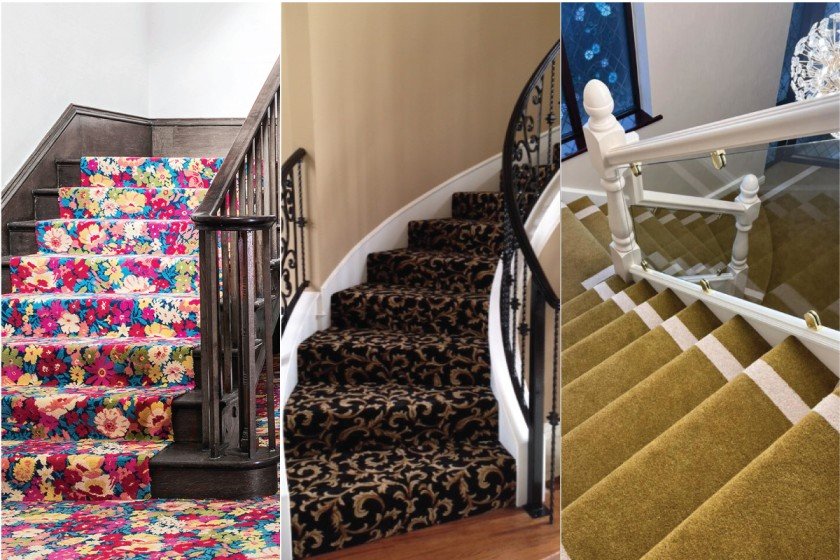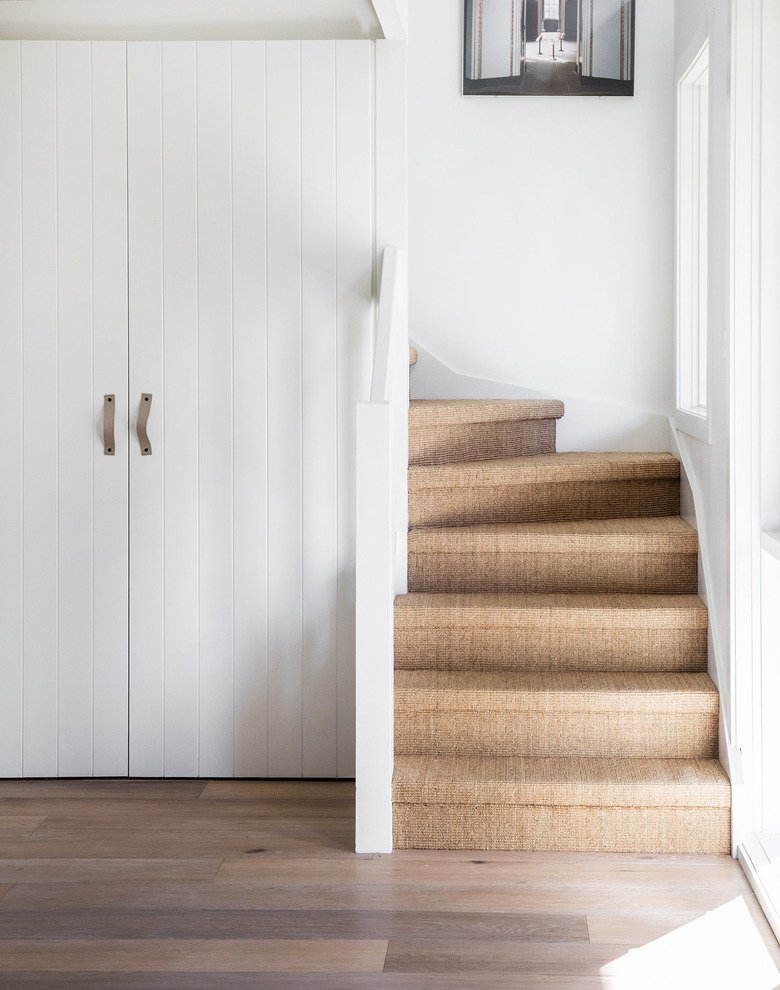
Carpet on stairs is both practical and stylish. It makes walking safe, reduces noise, and protects wood from scratches. It also adds warmth and color to spaces that often feel plain. Many homeowners see stairs as just a path between floors, but the right carpet turns them into a feature of the house.
This guide covers 12 detailed carpeted stair ideas. Each idea explains how it works, the benefits, and styling tips so you can make the best choice for your home.
01. Classic Neutral Carpets

Neutral colors never go out of style. Beige, cream, gray, or soft brown create a calm background that works in almost every interior. These shades make stairs feel clean and open, especially in small hallways.
A neutral carpet also blends with any wall paint or furniture, so you don’t need a full redesign. For families, mid-tone shades work best because they hide dirt better than very light ones. A beige carpet with a slight fleck of darker fiber, for example, disguises marks while still feeling bright.
Pros: Timeless, versatile, easy to match.
Cons: Light shades may show stains faster.
Styling tip: Add metal stair rods or dark handrails to create contrast against a light carpet.
2. Bold Patterned Carpets

Patterns bring energy to a staircase. Striking floral prints, geometric shapes, or Moroccan-inspired designs draw the eye and make stairs a centerpiece. A bold carpet also hides dirt better, since prints break up marks.
Dark backgrounds with bright patterns look dramatic, while lighter designs keep things fresh. For example, navy with white geometric shapes looks modern, while green with floral accents feels more classic.
Pros: Stylish, hides stains, creates personality.
Cons: May clash with busy wallpaper or colorful walls.
Styling tip: Keep surrounding décor simple so the stairs stand out instead of overwhelming the space.
3. Striped Stair Runners

Stripes are a favorite for stair carpets because they play with space. Vertical stripes (running up and down) make the stairs look longer and taller. Horizontal stripes (less common) add a playful, bold look.
Thin stripes in two or three colors feel traditional, while wide stripes in contrasting shades look modern. A gray runner with cream stripes feels subtle, while black and white wide stripes create drama.
Pros: Makes stairs look longer, adds energy.
Cons: Needs careful alignment so the stripes stay straight.
Styling tip: Use striped runners with plain walls so the effect feels balanced, not overwhelming.
4. Dark and Dramatic Carpets

Deep colors such as charcoal, navy, forest green, or chocolate brown give stairs a sense of richness. Dark carpets feel cozy and pair well with light-painted walls or white stair rails.
They also hide dirt and scuff marks better than light tones, making them practical for busy homes. In open-plan spaces, dark carpets add grounding and warmth.
Pros: Hides stains, looks elegant, adds warmth.
Cons: Can make small stairwells feel darker.
Styling tip: Use extra lighting, mirrors, or pale walls to balance the darker tones.
5. Two-Tone Stair Carpets
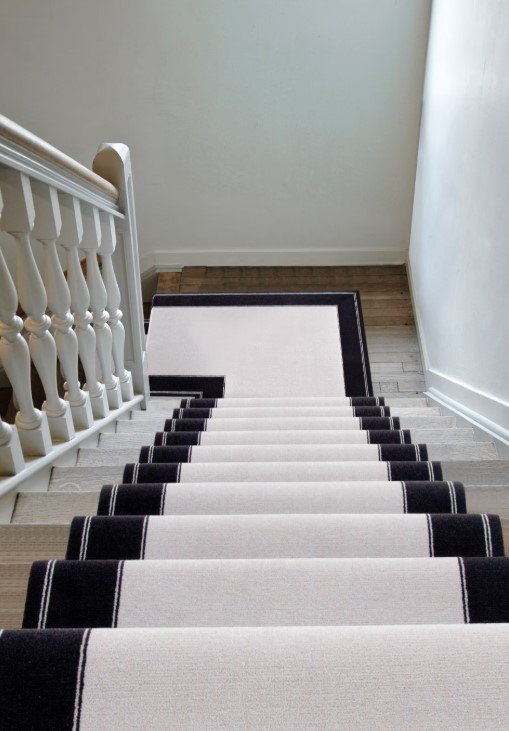
Two-tone carpets use two colors in one design. This might be a central color with a contrasting border or alternating tones in each step. A gray carpet with white borders, for example, looks crisp and modern.
This style is not only attractive but also practical. Borders define the stair edges clearly, which reduces the risk of tripping. Two-tone designs can also highlight the architecture of the staircase.
Pros: Stylish, safer, adds dimension.
Cons: Borders may show wear faster if lighter.
Styling tip: Match the border to railings or trim for a polished look.
6. Soft Plush Carpets

Plush carpets bring comfort to every step. They feel soft underfoot and absorb sound, making stairs quieter. Families with kids often enjoy plush carpets because they cushion falls.
Thicker piles create a luxury look, but mid-pile options are more practical for stairs since they resist flattening. Plush carpets in neutral mid-tones stay looking fresh longer.
Pros: Comfortable, quiet, elegant.
Cons: Shows footprints, less pet-friendly.
Styling tip: Pick a durable fiber like nylon for plush carpets on stairs to prevent wear.
7. Natural Fiber Carpets
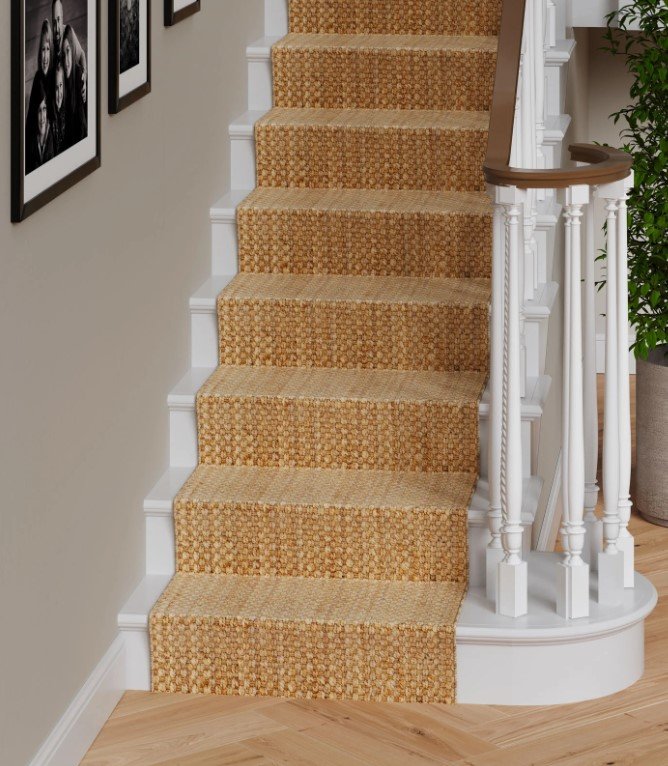
Sisal, jute, and seagrass give stairs a rustic, eco-friendly look. Their textured weave adds interest and pairs beautifully with wood railings. These carpets are hard-wearing and resist dirt.
While they are not as soft as wool, they bring a fresh, natural style. Seagrass, for example, has a subtle greenish tint, while jute gives a golden-brown warmth.
Pros: Eco-friendly, durable, textured look.
Cons: Not as soft underfoot.
Styling tip: Use natural fiber stairs with neutral walls and wooden floors for a natural, calm interior.
8. Runner with Exposed Wood Sides
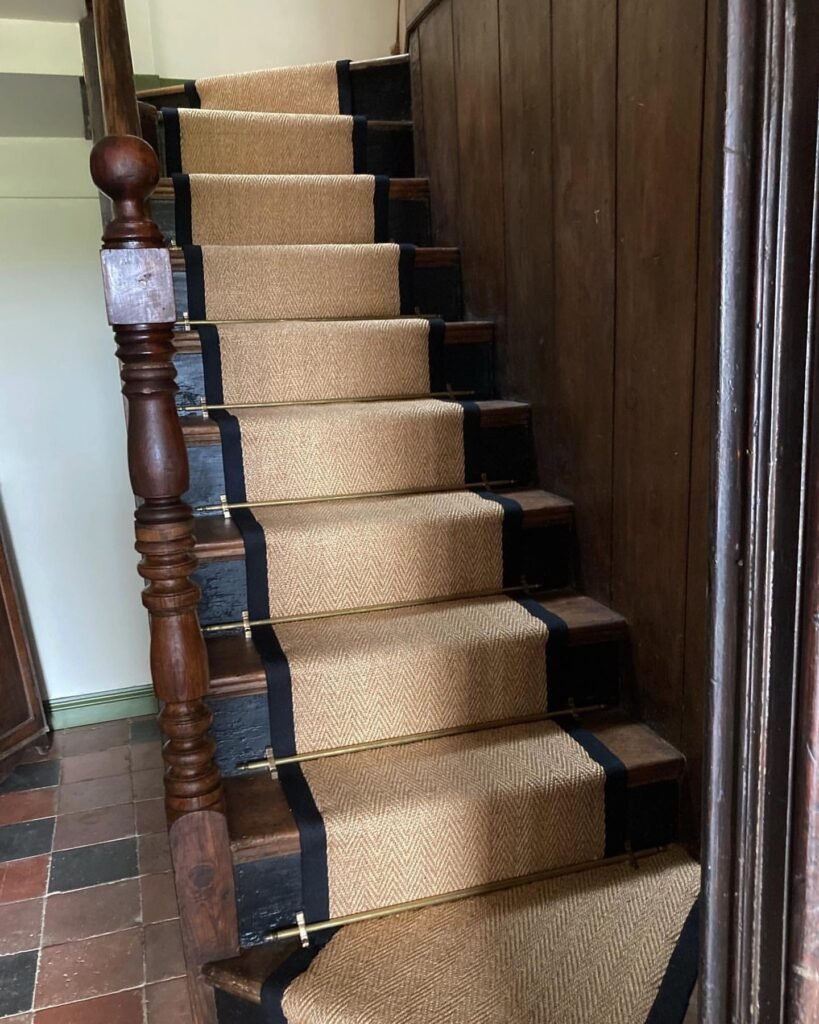
Instead of covering the full stair, a runner leaves the edges of the wood visible. This design looks classic and works especially well on polished hardwood stairs.
The runner protects the center, where most people step, while the visible wood adds contrast. Runners come in plain colors, stripes, or patterns, making them highly flexible.
Pros: Stylish, protects stairs, shows off wood.
Cons: Needs proper fitting to stay centered.
Styling tip: Use stair rods for a traditional look or keep it simple for a modern finish.
9. Carpets with Subtle Textures
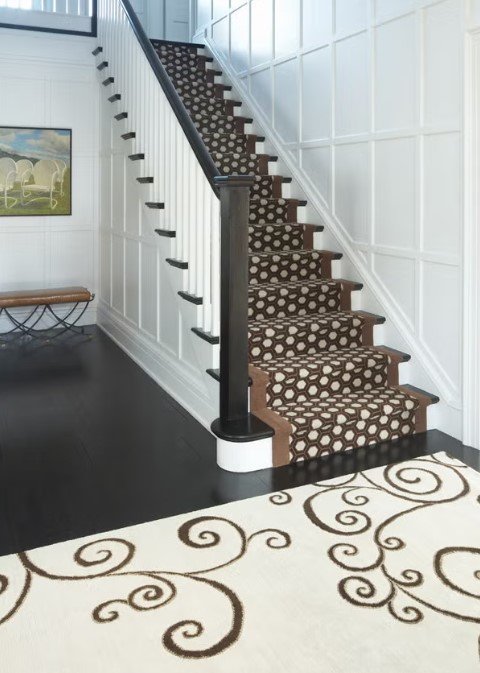
Not all carpets need strong colors or prints. Textured designs use loops, ribs, or weaves to add detail. These textures make stairs look refined without being too bold.
A ribbed or looped carpet, for example, adds grip and durability. Textures also hide marks and footprints better than smooth carpets.
Pros: Durable, hides marks, elegant.
Cons: Some textures feel rough underfoot.
Styling tip: Pair textured carpets with simple wall shades to keep the focus on the subtle detail.
10. Luxury Wool Carpets
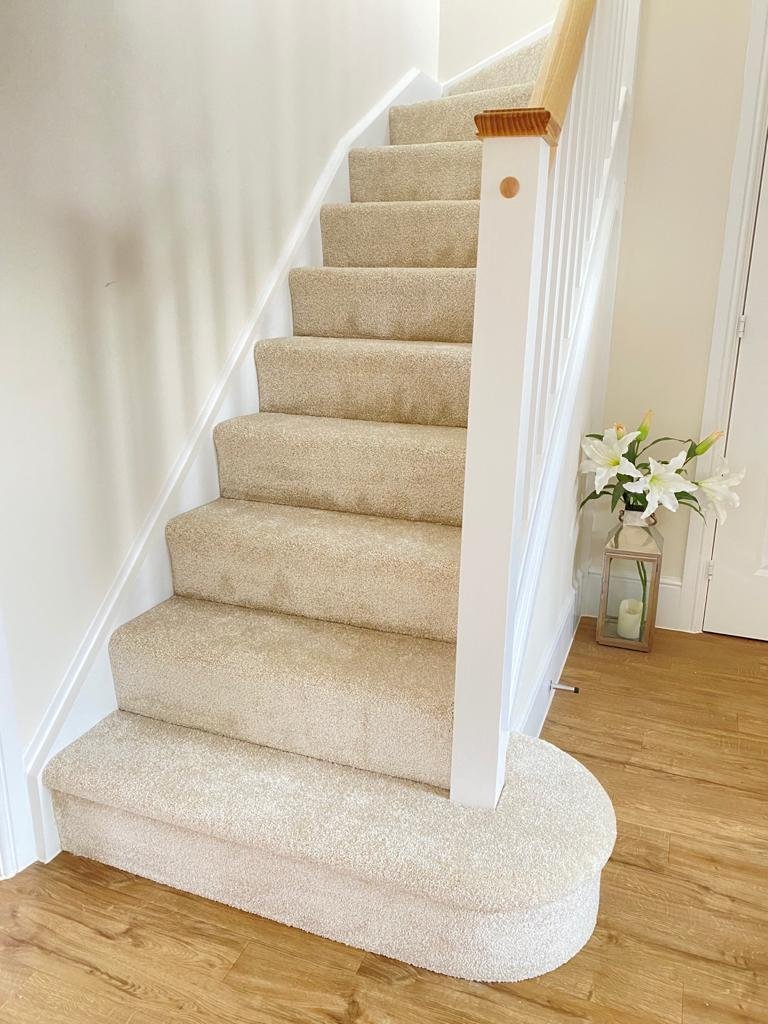
Wool remains one of the best choices for stairs. It’s naturally warm, soft, and durable. Wool also resists crushing and holds its color well.
A soft gray wool carpet looks timeless, while patterned wool brings energy. Though wool costs more than synthetic options, it lasts longer, often paying back the investment over time.
Pros: Durable, soft, natural, long-lasting.
Cons: Higher price.
Styling tip: Choose a wool blend for a balance of softness and extra durability.
11. Bright and Colorful Carpets
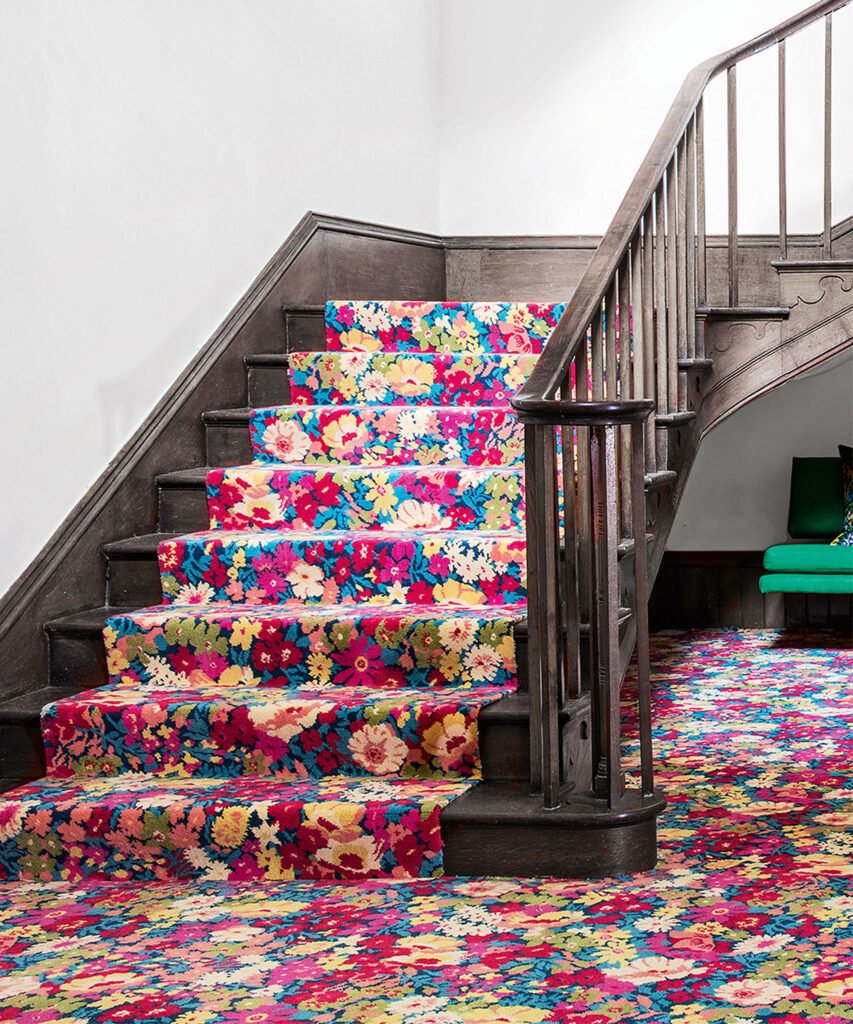
Strong colors make a staircase stand out. Red, teal, mustard, or emerald green bring character to otherwise plain hallways. These shades create a cheerful feel in family homes.
Bright carpets also suit eclectic or modern interiors where personality matters more than subtlety. Pair them with light walls so the colors shine without feeling heavy.
Pros: Fun, bold, energizing.
Cons: May feel too strong in small or dark spaces.
Styling tip: Use colorful carpets as a focal point, but keep nearby décor simple.
12. Customized Carpets with Borders
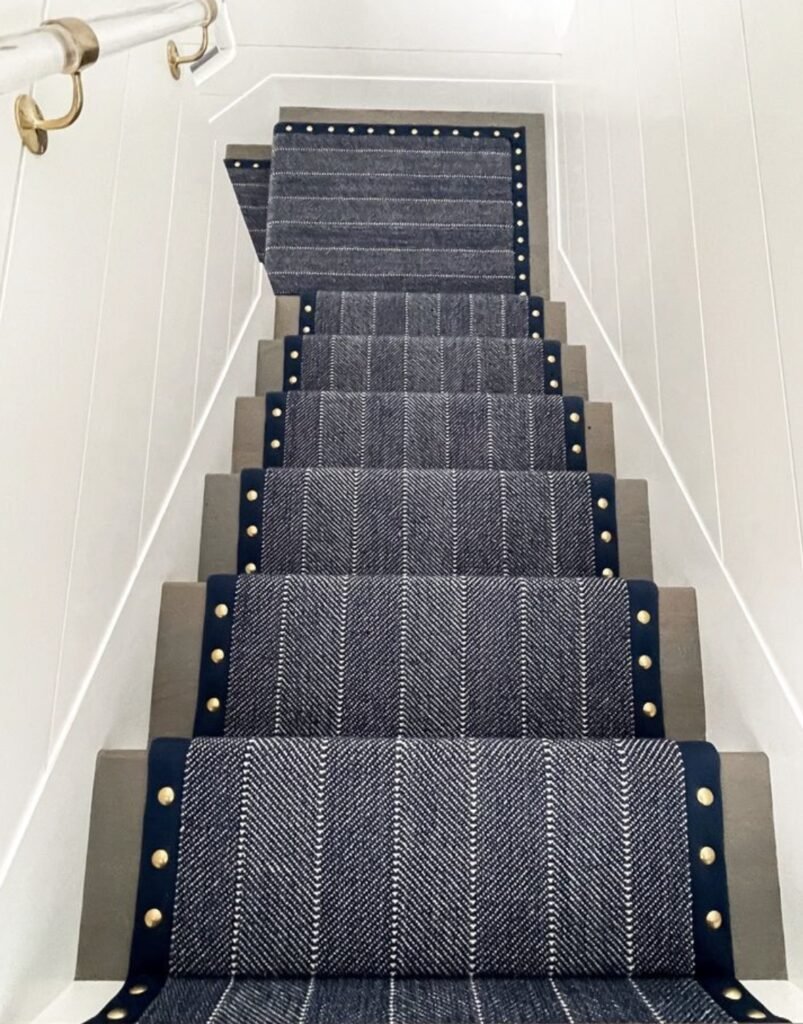
Custom borders add a final polished touch. A solid carpet trimmed with a darker edge, or a patterned runner framed with a simple border, makes the stairs feel special.
Borders also help define the steps, improving safety while looking stylish. Many carpet makers offer custom options, allowing you to match borders with paint, railings, or flooring.
Pros: Elegant, safe, flexible.
Cons: May cost more than standard designs.
Styling tip: Choose contrasting borders for drama or subtle tones for a refined finish.
Conclusion
Carpeted stairs improve safety, reduce noise, and bring beauty into the home. The right design also matches your style, from calm neutrals to bold patterns. Each of these twelve ideas shows how flexible stair carpets can be.
Neutral carpets work for timeless spaces, while bold patterns create drama. Plush carpets add comfort, natural fibers bring texture, and runners show off wood. Stripes, borders, or bright colors make stairs a key design feature. For durability and luxury, wool remains the best option.
Your choice depends on how you live. Families with children may want darker, durable options. Those who enjoy design may prefer stripes, patterns, or colorful carpets.
By selecting carefully, your staircase becomes more than steps between floors. It becomes a feature that adds comfort, safety, and personality to your home.

